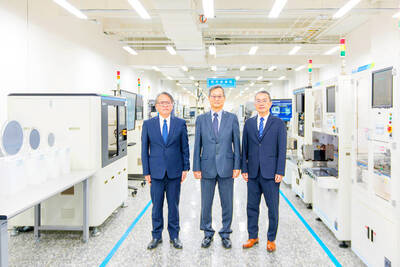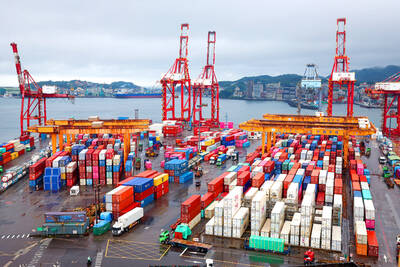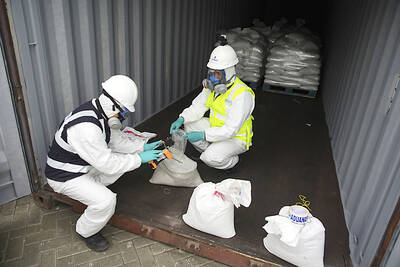Taiwan and the Philippines will conduct separate feasibility studies on a proposed bilateral economic partnership agreement, an official from the Chung-Hua Institution for Economic Research (CIER, 中華經濟研究院) said yesterday.
Kristy Hsu (徐遵慈), an associate research fellow at CIER, confirmed that CIER’s WTO Center in Taiwan would commence the study soon.
Meanwhile, the Manila Economic and Cultural Office has reportedly signed a contract with the Philippine Institute for Development Studies to carry out an assessment of the proposed pact.
Hsu said the CIER is also in charge of conducting feasibility studies on economic agreements with India, Indonesia and Malaysia.
Since Taiwan signed the Economic Cooperation Framework Agreement (ECFA) with China in June 2010, the nation has been looking to sing free-trade agreements (FTA) with other nations and has initiated free-trade talks with Singapore and New Zealand.
Taiwan has also started talks with South Korea on a bilateral investment protection agreement, after the two countries held the first round of talks on the issue in Taipei late last month and are scheduled to hold a second round of talks in Seoul later this year.
On Saturday, Minister of Economic Affairs Shih Yen-shiang (施顏祥) said finding entry points into the process of regional economic integration may be a big challenge for Taiwan, but it is necessary.
“Seeing our major trade rivals actively engaged in economic negotiations with their trade partners really worries us,” Shih said at a seminar held to discuss the impact of trade and investment liberalization measures. “It is now a game of either participating or being excluded.”
South Korea has FTAs with 45 countries, which account for 35.3 percent of its total trade volume, while Japan has FTAs with 15 countries that absorb 17.6 percent of its total trade, Shih said, citing a survey by Global Trade Atlas Navigator.
Singapore has recorded more than 70 percent of its total trade volume coming from its FTAs with 33 countries, he said.
So far, Taiwan has only forged FTAs with five Central American countries and the ECFA with China. The trade volume of the five FTAs and that of the ECFA’s tariff-free “early harvest” program account for 4.38 percent of Taiwan’s total trade, Shih said.
“We are under great pressure, and we know that we need to make huge improvements,” he said.

SMART MANUFACTURING: The company aims to have its production close to the market end, but attracting investment is still a challenge, the firm’s president said Delta Electronics Inc (台達電) yesterday said its long-term global production plan would stay unchanged amid geopolitical and tariff policy uncertainties, citing its diversified global deployment. With operations in Taiwan, Thailand, China, India, Europe and the US, Delta follows a “produce at the market end” strategy and bases its production on customer demand, with major site plans unchanged, Delta president Simon Chang (張訓海) said on the sidelines of a company event yesterday. Thailand would remain Delta’s second headquarters, as stated in its first-quarter earnings conference, with its plant there adopting a full smart manufacturing system, Chang said. Thailand is the firm’s second-largest overseas

‘REMARKABLE SHOWING’: The economy likely grew 5 percent in the first half of the year, although it would likely taper off significantly, TIER economist Gordon Sun said The Taiwan Institute of Economic Research (TIER) yesterday raised Taiwan’s GDP growth forecast for this year to 3.02 percent, citing robust export-driven expansion in the first half that is likely to give way to a notable slowdown later in the year as the front-loading of global shipments fades. The revised projection marks an upward adjustment of 0.11 percentage points from April’s estimate, driven by a surge in exports and corporate inventory buildup ahead of possible US tariff hikes, TIER economist Gordon Sun (孫明德) told a news conference in Taipei. Taiwan’s economy likely grew more than 5 percent in the first six months

SUPPLY RESILIENCE: The extra expense would be worth it, as the US firm is diversifying chip sourcing to avert disruptions similar to the one during the pandemic, the CEO said Advanced Micro Devices Inc (AMD) chief executive officer Lisa Su (蘇姿丰) on Wednesday said that the chips her company gets from supplier Taiwan Semiconductor Manufacturing Co (TSMC, 台積電) would cost more when they are produced in TSMC’s Arizona facilities. Compared with similar parts from factories in Taiwan, the US chips would be “more than 5 percent, but less than 20 percent” in terms of higher costs, she said at an artificial intelligence (AI) event in Washington. AMD expects its first chips from TSMC’s Arizona facilities by the end of the year, Su said. The extra expense is worth it, because the company is

The seizure of one of the largest known mercury shipments in history, moving from mines in Mexico to illegal Amazon gold mining zones, exposes the wide use of the toxic metal in the rainforest, according to authorities. Peru’s customs agency, SUNAT, found 4 tonnes of illegal mercury in Lima’s port district of Callao, according to a report by the non-profit Environmental Investigations Agency (EIA). “This SUNAT intervention has prevented this chemical from having a serious impact on people’s health and the environment, as can be seen in several areas of the country devastated by the illegal use of mercury and illicit activities,”